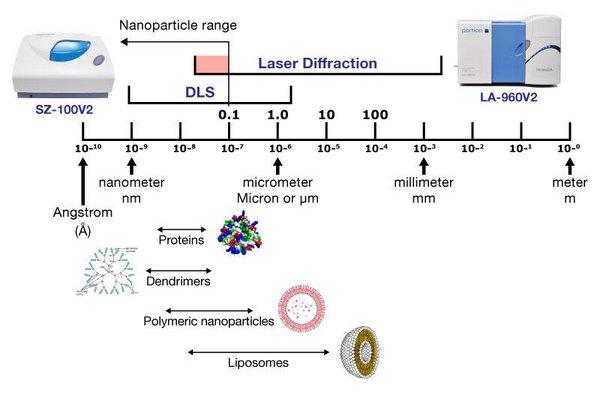

Nanoparticles used for drug delivery is an important research field combining the life sciences with nanotechnology. While the strict definition of a nanoparticle is between 1 – 100 nm, we can extend the upper size range in the context of this application up to approximately 500 nm.
The graph below shows a size scale from the Angstrom to the meter, along with the approximate size range of our particle size analyzers and some common nanoparticles used for drug delivery.

Nanoparticle drug delivery application size range with overlay of dynamic light scattering and laser diffraction technologies.
There is a cross over between dynamic light scattering (DLS) and laser diffraction within the range of 30 – 100 nm. DLS provides the advantage of being able to measure smaller particles (below 1 nm) using smaller sample volumes at lower concentrations. Laser diffraction provides the advantage of being able to measure larger particles (up to 3000 µm).
Polymeric nanoparticles have been successfully characterized using both techniques as show below. The results from DLS are typically slightly larger than laser diffraction results since DLS reports hydrodynamic radius as an intensity distribution. Read the What is the Z-Average? page for more about hydrodynamic radius.


Median Size : 0.07944 (µm)
Mean Size : 0.08295 (µm)
Mode Size : 0.0798 (µm)

Particle size of polymeric nanoparticles by DLS (top) and laser diffraction (bottom).
Particle size analysis of liposomes can also be performed using either DLS or laser diffraction, depending on the size of the liposomes.

Particle size overlay of multiple liposome measurements on the SZ-100V2.

Particle size results of a liposome measurement on the SZ-100V2.

Zeta potential overlay of multiple liposome measurements on the SZ-100V2.

Zeta potential results of a liposome measurement on the SZ-100V2.
The LA-960V2 Particle Size Analyzer and SZ-100V2 Nanoparticle Analyzer may be used to measure the particle size distribution and zeta potential (SZ-100V2) for drug delivery vehicles. These characteristics directly affect bioavailability, dissolution, immunotoxicity, amongst other critical formulation factors. The LA-960V2 requires only micrograms of material in some cases and the SZ-100V2 even less.
Nanoparticle Analyzer
Laser Scattering Particle Size Distribution Analyzer
Laser Scattering Particle Size Distribution Analyzer
Static Image Analysis System Particle Size
Do you have any questions or requests? Use this form to contact our specialists.